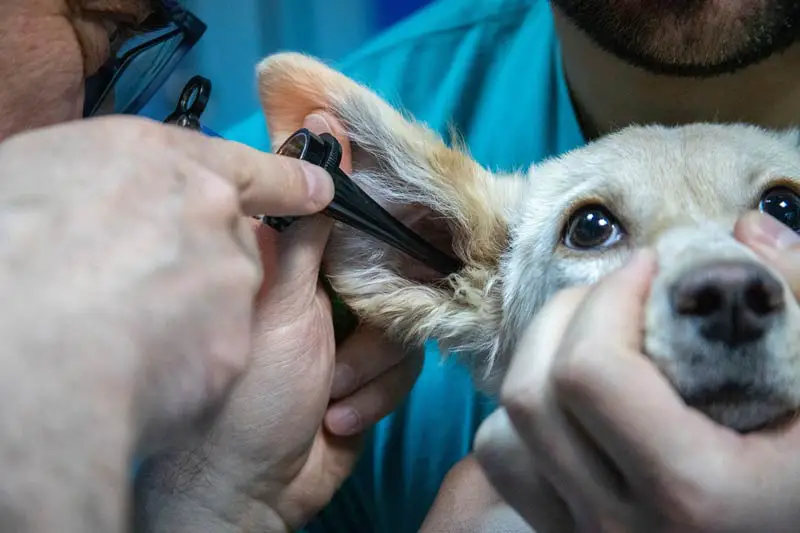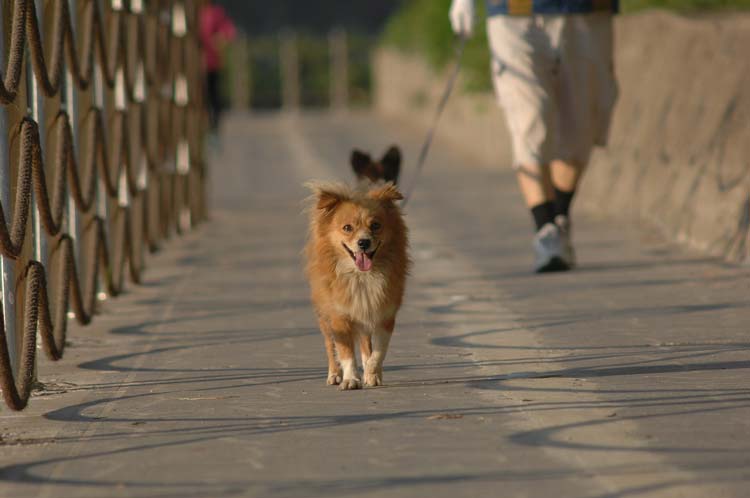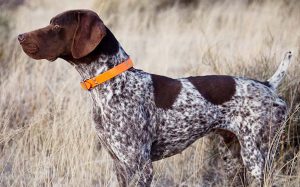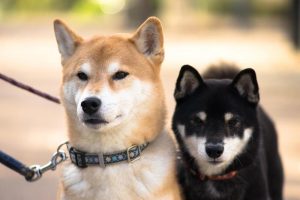With their long bodies and short legs, Dachshunds are anything but adorable. Top it with the big, melting eyes, and your pup becomes too-cute-to-ignore. So much that you end up feeding your pooch more than required.
But, are you feeding your Dachshund the right amount of food? The correct amount of food for your Dachshund depends on factors like weight, age, activity levels, and health conditions, among others. Make sure to feed your doggo quality food that suits its needs perfectly.

These canines are highly vulnerable to obesity and other health concerns that occur due to an incorrect diet. Moreover, every pooch has a distinct digestive system, so you cannot feed your pup the standard dog food or leftovers from your plate.
See also:
Does it sound daunting? Walk through this feeding guide for a Dachshund to get a detailed insight into the right food for your Doxie. From feeding charts and schedules to food type and healthy habits, this piece has well-rounded Dachshund feeding information. Jump in!
Page Contents
When To Start Feeding Dachshund Puppies Food
At the age of around 4 weeks, your puppy’s calorie requirement is not fulfilled solely by its mother’s milk. That is when you need to start feeding your Dachshund pooch solid puppy food.
Your pup is not used to eating dry food at this age, which is why you need to moisten it a little. You can prepare the perfect meal by soaking dry puppy food in water and mix it with a milk replacer.
Once your tiny friend’s tummy is habitual to dog food, decrease the moisture content every 3-4 days. At about 5-1/2 to 6 weeks of age, your Doxie pup will be fully prepared to feast on completely dry food.
How Much To Feed A Dachshund – Feeding Behavior
So, what is the right amount of food, and how much should you really feed a Dachshund? When it comes to dog food, you will not find a one-size-fits-all. And still, you need to maintain the correct amount and quality of food to prevent nutrient deficiencies and obesity.
Here are the standard feeding quantities for a Dachshund.
- 10 pounds: 3/4 cups of day
- 15 pounds: 1 cup per day
- 20 pounds 1-2/3 cups per day
Note: Divide them into different meals (discussed in the following sections) according to your Dachshund’s growing stage.
Well, it is a big responsibility, but this article got your back. You got to personalize your pooch’s feeding schedule according to multiple different factors. Also, once you have it, stick to the plan for your pup’s thriving health and body.
Dachshund Growth Chart
| Age in months | Weight in Pounds | Weight in Kilograms |
|---|---|---|
| 1 month | 1.5-3.8 lbs | 0.7-1.7 kg |
| 2 months | 3.5-8.5 lbs | 1.6-3.8 kg |
| 3 months | 6-15 lbs | 2.7-7 kg |
| 4 months | 8-20 lbs | 3.6-9 kg |
| 5 months | 9-24 lbs | 4-11 kg |
| 6 months | 10-26 lbs | 4.5-12 kg |
| 8 months | 11-30 lbs | 5-13.5 kg |
| 10 months | 11-31 lbs | 5-14 kg |
| 12 months | 11-32 lbs | 5-14.5 kg |
| 24 months | 11-32 lbs | 5-14.5 kg |
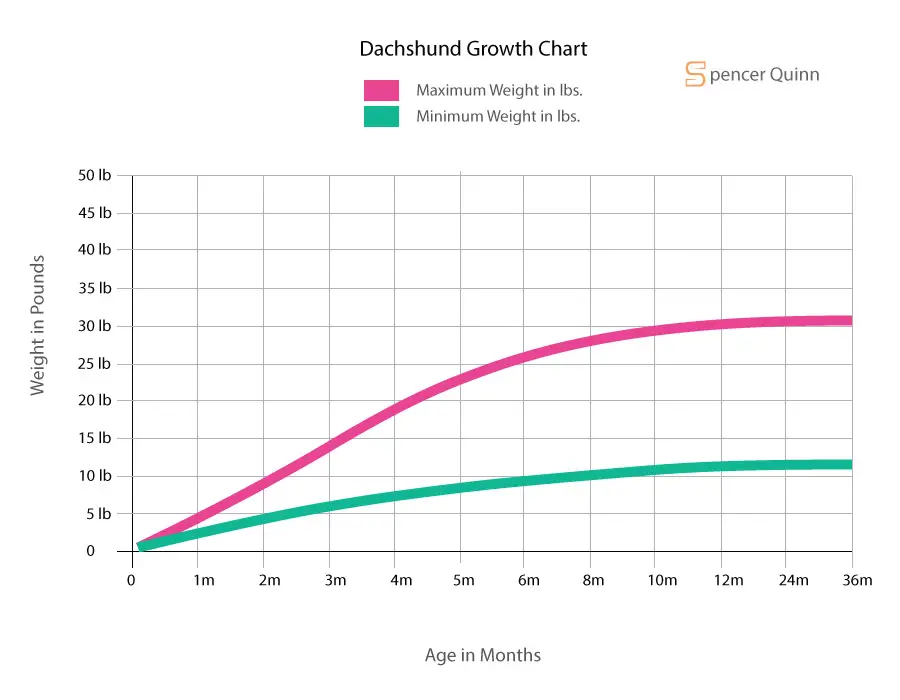
Feeding Schedule By Age
Your Dachshund’s appetite is highly regulated by its age. Plus, an average puppy has different nutritional requirements than an adult. And when a canine reaches the senior phase, its appetite is bound to decrease while the nutrient needs persist.
Puppy
Pups have a higher metabolism rate than adult doggos, which is why they need to eat more frequently than their bigger counterparts. Also, they have booming energy levels, so you must feed them a diet rich in protein and fatty acids. Refer to the table below to ascertain the number of portions/meals for your pup.
Number of Meals for A Dachshund Puppy Based On Age (per day)
| AGE | MEALS |
| 2-4 months | 4 |
| 4-6 months | 3 |
| 6-8 months | 2-3 |
| Over 8 months | 2 |
Adult
Once your Doxie is 12 months or older, you can stick to feeding 2 meals per day. You can determine the exact amount based on weight, food package, and other factors discussed in the following sections.
Your adult pooch needs comparatively less protein, calories, and fats than a pup due to reduced metabolism rates. Make sure to control the calorie intake as Doxies tend to gain weight pretty soon.
That being said, remember that this is the most energetic phase of your doggo’s life. From body changes to high activity needs and more, your Dachshund needs quality food to suffice all the body requirements.
Senior
When your Dachshund reaches 7 years of age, your pooch has become a senior dog. You will notice how your doggo’s appetite has drastically decreased. Moreover, old dogs usually nap around more and have significantly lower activity levels.
Though you may still feed the furball twice a day, the doggo may not always gobble up all the food. This can result in a nutrient deficiency that makes way for several health conditions.
At this stage, you must choose senior dog foods that are rich in fiber and aid your pooch’s joint health and digestion. Continue giving your senior Dachshund 2 small meals as it will leave enough time for digestion without causing deficiencies.
Dachshund’s Weight
Is your Dachshund overweight, or is its weight lower than the standard? First, you need to determine whether your Doxie falls in the correct weight range. The ideal weight for a standard Dachshund is 16 to 32lbs, and for a miniature Dachshund, it is up to 11lbs.
Here are a few factors you can weigh to establish whether your munchkin is healthy, underweight, or overweight.
- Do you see more than the last two ribs of your pooch sticking out when it stands?
- When you touch your furball’s sides, can you feel the rib easily, moderately, or not at all?
- When your Dachshund is standing, is its belly in line with the chest, or is the chest closer to the ground?
Once you have thoroughly examined all the points, compare them with this dog body chart. If you doggo is overweight (2-5lbs more than ideal mass) or underweight (1-3lbs lower than standard), fix the food amount accordingly.
Here is a chart displaying the total calories an adult Dachshund must consume per day, based on its weight.
Calorie Consumption of An Adult Dachshund Based on Weight
| WEIGHT (Kgs/Pounds) | TOTAL CALORIES | PROTEIN (calories) | CARB (calories) | FATS (calories) |
| 4/8 | 242 | 55.5 | 157.3 | 30.3 |
| 6/13 | 363 | 81.7 | 236 | 45.4 |
| 8/17 | 484 | 108.9 | 314.6 | 60.5 |
| 10/22 | 605 | 136.1 | 393.3 | 75.6 |
| 12/26 | 726 | 163.4 | 471.9 | 90.8 |
| 14/30 | 847 | 190.6 | 550.6 | 105.9 |
| 16/35 | 968 | 217.8 | 629.2 | 121 |
Scan the Food Package
Once you are well aware of your pooch’s weight, check the dog food package for the recommended quantity. It is an excellent guide to let you determine the right amount of food for your Dachshund. You must note that the mentioned quantity is for a 24-hour period.
You can further divide this amount based on the number of meals your doggo should be taking. That is, according to your furball’s feeding schedule by age.
Dachshund’s Activity Level
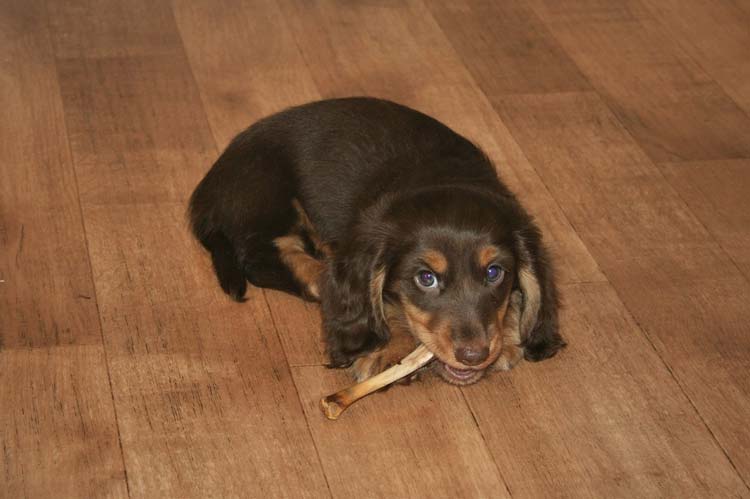
Another vital aspect that can affect your Dachshund’s food requirements is its activity level. If your doggo is highly active, increase the food dosage slightly more than recommended. That is if your pooch walks or conducts other exercises for an hour every day.
On the contrary, if your Doxie has a sedentary lifestyle, you will have to decrease the daily food content.
Calorie Intake
Does your doggo nibble on titbits other than the daily meals? You need to track your Dachshund’s eating habits and calorie intake. For example, if you shower your pooch with multiple treats round the day, you get to restrict the quantity of regular food.
Besides, if you feed the canine from your plate and other table scraps, consider reducing the amount of food in the dog bowl. Additionally, if you swap the dog food brand, thoroughly check the new food’s calorie content and determine accordingly.
Dachshund Nutrient Requirement (MERCK Manual)
| GROWTH STAGE | PROTEIN | FAT |
| Puppy | 22% | 8% |
| Adult | 18% | 5% |
| Senior | 28-32% | 3-5% |
Diet and Nutrition
Other than the amount of food, you also need to consider the type and quality of food. Most commercial dog foods have a balanced nutrient content according to the age of the doggo. Alternatively, you can prepare a home cooked or raw diet for your pooch.
Here is all you got to know about the different dog food categories.
Types of Food
Kibble/Dry Food
One of the most popular, high-quality food for Dachshunds is kibble. It is dry dog food that comes in varying shapes and sizes, usually loaded with nutrients. You must choose a kibble packet, specially formulated for a puppy, adult, or senior, accordingly.
These foods have different nutritional values based on the dog’s age and breed. So, consider looking for kibble for small dog breeds. Also, choose premium quality food to ensure your Doxie’s health.
Wet Food
If your Dachshund is a tad bit picky with food, try your hand at wet dog food. It is a comparatively tasty option that your canine friend is sure to love. This food has a meaty aroma, attracting your pooch to gobble up the entire food. Plus, it helps increase your munchkin’s water intake.
That being said, wet food can be rather expensive and is not the best choice for your pooch’s dental health. That is because it will not clean your furry friend’s teeth, as well as kibble does.
The best mid-way option is to feed your pooch a mix of kibble and wet food. Alternatively, you can stick to kibble and give wet food occasionally as treats.
Home Cooked Food
Preparing a DIY meal for your Dachshund is an excellent way of regulating your furball’s diet. This way, you know exactly what the furball is consuming. Plus, you can easily increase or decrease the calorie content, nutrients, etc., to regulate your furry friend’s weight and diet.
That being said, preparing a well-balanced meal can get challenging. Though you can consult your vet about the nutrients required by your munchkin, you may not have enough time at hand.
BARF (Raw Food)
Biologically Appropriate Raw Food (BARF) has some hard to ignore positive effects on your canine friend. It is good for their dental health, keeps the coat healthy, and also aids digestion. Still, it requires added effort from your side.
Similar to home cooked food, you will have to make sure your furry mate gets a nutritious diet to prevent deficiencies. More so for puppies, as a deficiency can hamper your munchkin’s growth.
Foods to Avoid
With the multiple types of dog foods, choosing one may not be challenging. But what about the ‘human food’ that your doggo eats. Thoroughly skim this list of foods to avoid for Dachshunds to save your pooch from any adverse health effects.
- Alcoholic foods and drinks
- Grapes, raisins, and dates
- Almonds and walnuts
- Salty food
- Chocolate, coffee, or anything containing caffeine
- Yeast dough
- Onion and garlic
- Milk and dairy products
- Raw meat and eggs
- Citrus foods
- Raw or cooked bones
- Coconut based items
Recommend Dog Food
Now that you know the food items to keep at bay, here are some you can readily feed your Dachshund.
Recommended Dog Food
- Blue Buffalo Life Protection Formula
- Purina Pro Plan
- Nutro Natural Choice
- Hill’s Science Diet Dry Dog Food
- Wellness Complete Health Natural
Safe Human Food
- Carrots, corn, tomatoes (limited), green peas, broccoli, etc.
- Cooked eggs, fish, and meat (boneless)
- Fruits like berries, pineapple, watermelon, apple, etc.
- Cheese (limited)
- Bread, oatmeal, rice, and other grains
Q&A
Both mini and standard Dachshund pups can start eating regular dog food by the age of 3-4 weeks. At this point, their mother’s milk does not fulfill their nutrient requirements, which is why you can slowly shift to solids. Start by feeding water or milk-soaked dog food for 1-2 weeks.
The frequency of feeding your Dachshund depends on its growth stage. Give your Doxie pup 3-4 meals a day, according to the munchkin’s activity levels. On the contrary, adult and senior Dachshunds need to be fed 2 meals per day.
You can decrease the amount of food for your senior canine owing to their low nutrient needs. Still, divide it into two meals for easier digestion.
Wrap Up
The amount or frequency of feeding is not the same for every pooch, even if they belong to the same breed. Your active Dachshund pup may have different nutrient needs than your neighbor’s lethargic pooch.
Consider factors like age, weight, activity levels, calorie intake, type of food, etc., to determine how much to feed a Dachshund. Also, compare your current feeding routine to the standard one and make changes accordingly.
Irrespective of the food you choose, maintain a balanced diet and adequate physical activity to keep your Dachshund’s health thriving!

